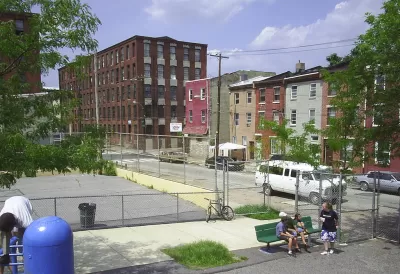A co-curricular program at a Philadelphia medical school integrates public health and city planning.

The links between health and urban design have been studied since modern cities began to rise, and contemporary research has continued to chart the impacts of noise pollution, air quality, access to nature, and proximity to highways or major streets on physical and mental health. But only since 2015 has there been a university program combining medical practice, public health, and city planning to take a holistic view toward wellbeing in cities.
The JeffDESIGN program at Thomas Jefferson University Medical School has as its mission to "design healthier cities, find more efficient ways to deliver care and develop the next generation of medical devices." In a feature on Next City, Bill Bradley describes student projects ranging from mapping the inefficiencies of hospital layouts to designing a better playground by monitoring how kids play.
Launched in February 2015, the program focuses on a broad range of design applications aimed at impacting real people’s health, from 3D printing that will help improve surgery to redesigning the physical space of hospitals. Most importantly, it’s about exploring the ways infrastructure, community and the built environment can have a positive impact on health.
FULL STORY: These Future Doctors Are Learning How to Influence Urban Design

Trump Administration Could Effectively End Housing Voucher Program
Federal officials are eyeing major cuts to the Section 8 program that helps millions of low-income households pay rent.

Planetizen Federal Action Tracker
A weekly monitor of how Trump’s orders and actions are impacting planners and planning in America.

Ken Jennings Launches Transit Web Series
The Jeopardy champ wants you to ride public transit.

Crime Continues to Drop on Philly, San Francisco Transit Systems
SEPTA and BART both saw significant declines in violent crime in the first quarter of 2025.

How South LA Green Spaces Power Community Health and Hope
Green spaces like South L.A. Wetlands Park are helping South Los Angeles residents promote healthy lifestyles, build community, and advocate for improvements that reflect local needs in historically underserved neighborhoods.

Sacramento Plans ‘Quick-Build’ Road Safety Projects
The city wants to accelerate small-scale safety improvements that use low-cost equipment to make an impact at dangerous intersections.
Urban Design for Planners 1: Software Tools
This six-course series explores essential urban design concepts using open source software and equips planners with the tools they need to participate fully in the urban design process.
Planning for Universal Design
Learn the tools for implementing Universal Design in planning regulations.
Heyer Gruel & Associates PA
Ada County Highway District
Institute for Housing and Urban Development Studies (IHS)
City of Grandview
Harvard GSD Executive Education
Toledo-Lucas County Plan Commissions
Salt Lake City
NYU Wagner Graduate School of Public Service





























